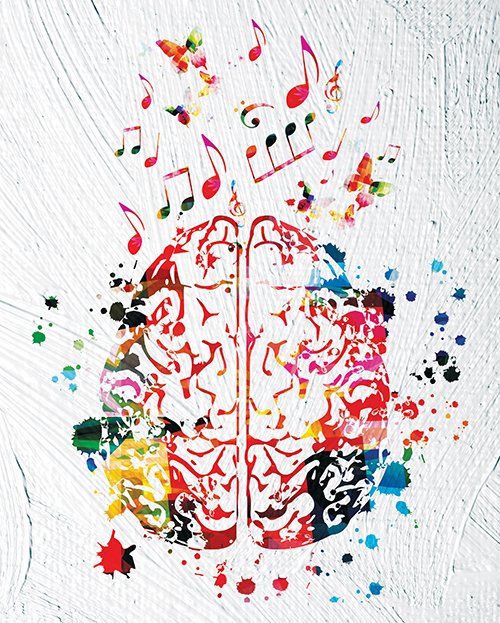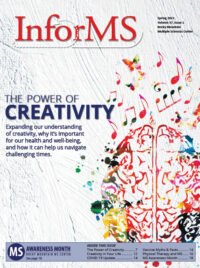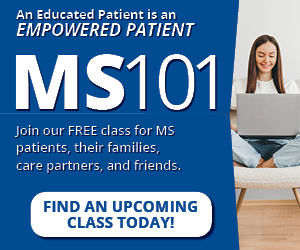
Expanding our understanding of creativity, why it’s important for our health and well-being, and how it can help us navigate challenging times.
When we first see the word “creativity” in big bold letters, some of us might instantly question its relevance or importance in our lives. We might think to ourselves, “Well, sure that’s great, but I’m not really a creative person. This topic doesn’t really apply to me.” But, the truth is that creativity is fundamentally about doing meaningful and fulfilling activities that you enjoy. In fact, we all have the power of creativity. And research shows us that deploying it in our lives has many positive impacts on health and is a vital component for our overall well-being.
As each of us continues to navigate these extraordinarily challenging times, adding to anyone’s pressure-filled “to do” list is definitely not our aim. Individuals and families are juggling overwhelming demands in every facet of life as we find our way through this devastating pandemic. The challenges are infinite and painfully wide-ranging: coping with many layers of uncertainty, health concerns and safety, loss and grief, increased isolation, job loss or changes, increased and ever-expanding roles of parenting, remote learning for children, financial concerns, and the list goes on. And, of course, all of these persistent difficulties are heaped on top of the already daunting realities in managing the complex challenges of living with MS.
Recognizing this stark reality, we are hoping to spark ideas for different ways to release some pressure valves and perhaps help to reduce a little stress and anxiety by exploring creativity. Please take only what you need and if this topic or the ideas don’t resonate with you right now, that is absolutely okay. Life is exceedingly complicated and we all know that there are no easy, one-size-fits all answers. If only that were the case, right?
Here we will explore what the research tells us about the benefits of creativity for health and well-being; the broad variety of ways (big and small) to incorporate more creativity into your life; and resources for cultivating your own creativity.
UNDERSTANDING CREATIVITY AND ITS BENEFITS
Mihaly Csikszentmihalyi, author of the book Creativity: Flow and the Psychology of Discovery and Invention describes creativity as, “A central source of meaning in our lives …Most of the things that are interesting, important, and human are the results of creativity. When we are involved in it, we feel that we are living more fully than during the rest of life.”
Start where you are. Use what you have. Do what you can. — Arthur Ashe
Research shows us that creativity has many physical and mental benefits for our health and wellbeing. Let’s start with the mental health benefits. Similar to how exercise works out your body and maintains your physical health, creativity, and the processes involved with curiosity and learning, can help to maintain your mental well-being. Engaging in creative activities has been shown to combat depression, increase positive feelings, and to reduce stress and anxiety. Doing something creative has a similar effect on our brains as meditation.
And the great news is that this applies to whatever activity you choose to do. The process of getting immersed in an activity that kindles your imagination and focus – such as writing, listening to music, baking, reading, crocheting, or painting just to name a few – helps to release tension, boost your mood, and even lowers your heart rate. According to a study originally published in the American Journal of Public Health, the simple act of being in the presence of creativity can also have significant positive impacts on your state of mind. Practically speaking, this could include taking part in an online class, going on a virtual tour of a museum, or tuning in to listen to a live musical performance.
Engaging in creative activities also fundamentally contributes to maximizing lifelong brain health. “Research shows us that if you have an active life infused with creative activities, you have a larger neurological reserve, helping to build a more resilient brain,” explains Michelle King, Certified Therapeutic Recreation Specialist and King Adult Day Enrichment Program (KADEP) Senior Director at the Rocky Mountain MS Center. “Your brain is more capable and resilient to weather life’s constant battles if you’re regularly engaged in something you enjoy.”
Indeed, studies indicate that self-expression has many beneficial effects on cognition, emotional health and underscore the idea that taking part in novel, creative experiences has a protective effect on the brain. The principle investigator of a 2015 Mayo Clinic study explains: “Our study supports the idea that engaging the mind may protect neurons, or the building blocks of the brain, from dying, stimulate growth of new neurons, or may help recruit new neurons to maintain cognitive activities in old age.”
Creative pursuits are important for maintaining and improving cognitive brain function and health. Cognitively stimulating activities can include word puzzles, jigsaw puzzles, gardening, learning a new language, playing a game, knitting, painting or even a simple activity that is new to you and requires a thought process to learn. “These types of activities help to maintain and improve attention span, our memory, our processing skills, and our visual-spatial skills,” says Emily Nelsen, Certified Recreation Therapy Specialist and Programming Director at the MS Center’s King Adult Day Enrichment Program (KADEP).
CREATIVITY: A COPING & RESILIENCE TOOL
Resiliency is a dynamic concept and process. A much-simplified definition of resilience can be understood as a process of adapting well in the face of adversity, trauma, tragedy, threats, or significant sources of stress. Many research studies about resiliency point out that creativity is a key characteristic, behavior, or disposition that helps individuals to cultivate resilience. Creativity can help us deal with stress, adapt and innovate solutions to help address problems or limitations, and to enjoy life. We can think about creativity as both something we do and also an attitude or approach to life.
A 2016 study published in The Journal of Positive Psychology concluded that “spending time on creative goals during a day is associated with higher activated positive affect on that day.” Positive affect simply means the level of positive moods – such as joy, happiness, and optimism – that people experience. Higher levels of positive affect make it easier for an individual to focus on possibilities in their life. Focusing on life’s possibilities contributes to the ongoing practice of cultivating resiliency, especially when navigating life with a chronic disease like MS.
ADAPTATION IS CREATIVITY
The challenges of this past year have reinforced the importance of adaptation. Individuals living with MS understand even more acutely that adaptation is a critical tool and lifelong practice. The impacts of the pandemic have required people to find even more adaptive solutions. The reality is that adapting is often incredibly frustrating and can be very overwhelming, exhausting, and difficult. At the same time, it can present us with new opportunities we may not have thought about or tried that can ultimately improve the quality of our life.
During a recent conversation with a group individuals living with MS, we began talking about the different ways people incorporate creativity in their lives. Jan shared several activities she enjoys doing including crocheting, photography, and painting. Susan then shared the challenges she has had with tremors in her hand and that she wasn’t able to create the holiday cards for friends and family that she’d always enjoyed doing. Susan described the ways that she is now creating the cards using the voice dictation app on her phone so that she is still able to compose her holiday letters to share each year which continues to give her joy. Upon hearing Susan describe her experience, Jan said simply: “What you just described is the true essence of creativity.”
The conversation was such a poignant reminder of the importance of adaptation to continue doing things you enjoy and the power of creative adaptation to help improve our lives. If you have challenges with mobility or cognition, there are so many technological resources these days that can help you adapt most any activity to meet your needs. By googling “adaptive knitting” or “adaptive painting,” for an example, you will find lots of unique resources. If you don’t enjoy writing or have a hard time using your hands, another option is to dictate your thoughts or feelings. Like Susan, you can use your phone’s “Voice Memo” app, or any other digital recording device to easily capture your words. Creative adaptations can be found in many arenas.
For more ideas, take a look at some of the digital apps and resources we’ve compiled to spark or channel your creativity in new ways in “Creativity Apps” on the right side of this page.
ENDLESS POSSIBILITIES: MUSIC, VISUAL ARTS, MOVEMENT, EXPRESSIVE WRITING & READING
Music is one of the most researched areas of art and health intersections. According to a comprehensive literature review published by the American Journal of Public Health in 2010, music therapy can calm neural activity in the brain to reduce anxiety and that may also help to improve immune system functioning. And there is evidence that auditory stimulation can also be a helpful strategy for helping to manage pain.
Individuals living with MS also utilize music in a variety of creative ways to help manage MS symptoms – everything from playing instruments, singing, taking part in musical therapy classes, and listening to music while exercising or walking. For example, Rebecca has always loved music. To help her cope with stress, anxiety and pain she experiences while living with MS, she has created different playlists that include a variety of her hand-picked favorite songs and soothing sounds. She’s made other playlists for music that helps her to keep motivated while walking or stretching. The songs she selects help her to feel calmer and provide a boost for her mood. We spoke with other individuals who create playlists with tools like Spotify or Pandora to listen to while exercising based on their moods and the weather. For them, the songs lift their spirits or give them energy on gloomy days and calm them on anxiety-filled days.
A small study published in Neurorehabilitation and Neural Repair in 2019 focused on a rehabilitation technique called rhythmic auditory cuing. Researchers found that that pairing walking to rhythmic music could be an effective strategy for helping improve walking in people with MS. Participants also reported reductions in physical and cognitive fatigue when walking to music. Additional studies are also underway to look at how music might improve learning and balance in MS.
Visual art helps individuals to express themselves about experiences and challenges that are difficult to put into words. In a 2014 study conducted at Brunel University in the United Kingdom to look at whether art-making was a beneficial leisure activity for people with MS, researchers found that art-making contributed to overall life satisfaction and gave individuals a sense of time well spent. Benefits also included improved sense of emotional wellbeing. Participants felt they could express themselves through their art and that it helped them to maintain their identity, especially as they were experiencing new barriers and limitations in their life due to MS. Art therapy has also been found to stimulate cognitive function in older adults who have dementia or related disorders.
When she started taking art classes at KADEP, Destiny Morland wasn’t sure it would be the right fit for her. “I didn’t know I was an artist,” says Destiny, “Then I started taking classes and before I knew it, I was painting and drawing. My first drawing was a dreamcatcher which I drew in pencil. It turned out so well.” Destiny sought out all of the arts and crafts classes that KADEP had to offer including watercolor, acrylic painting, drawing, ceramics, tie dying, calligraphy, and crocheting. “KADEP has brought out the artistic me that I didn’t even know I had. It has really helped me bring out my creative abilities.”
Sarah Richter Gabel, a Denver artist living with MS, created an installation titled Infinite Refraction which was featured at Hinterland Art Space in Denver. The installation gave viewers sense of what Sarah saw and felt when she had triple vision. Sarah created a second exhibit titled Sensory Paradox, a multi-disciplined, interactive experience with elements representing her interpretations of some common MS symptoms – including fatigue, vertigo, visual changes and auditory distortions – that are often difficult to explain to others. “In my experience of living with this condition, I’ve found it to be a fluid and dynamic process. It’s challenging to imagine what the experience is like for people who live with the disease every day,” Sarah explained. “It’s especially challenging when we consider that MS symptoms and severity greatly vary from one person to the next, come and go, and are often invisible.”
Arts and crafts can come in endless forms, of course. During a recent conversation, Francie shared that she knits with a friend over Zoom. They had originally belonged to a book club, but that was too much when she had brain fog. When her fingers are weak or uncoordinated, she knits with the help of a circular loom that helps hold the project.
Movement is another important form of creativity. We know that movement and exercise are important for our health and well-being and are another key way to maximize lifelong brain health especially when living with MS. Exercise, particularly aerobic workouts, stimulates Brain Derived Neurotrophic Factor, which encourages the growth of new brain cells in the hippocampus. Exercise tends to help us think more clearly and boosts our moods. And movement is also both a form of creative expression and an important tool to help spark creativity in everyday life. Studies have shown that there is a relationship between movement and originality. And a recent study published in Scientific Reports, researchers identified an association between higher levels of activity and higher levels of creativity in individuals. In a 2014 Stanford University study, researchers found that walking boosts creative output by 60 percent.
Exercise helps us reduce stress, enhance our memories, and may also help us come up with new ideas. And the great news is that there are so many ways to move – whether it’s seated exercise classes, moving to music for a dance party (solo, with family, or even online with friends) or adaptive yoga classes. More ideas for online resources for staying active while staying close to home can be found in the MS Center’s Resource Guide.
Another form of creativity can be found in reading and expressive writing. Journaling is simply a way of recording our thoughts and feelings. Journaling is particularly beneficial because it necessitates both the analytical and rational side and the creative and emotional side of the brain. It has been found to boost your mood, enhance your sense of well-being, reduce symptoms of depression, and improve your working memory. Studies also suggest that journaling can strengthen the immune system, drop blood pressure and help improve your sleep.
Journaling also provides for a lot of flexibility and room to adapt and there are no rules. For example, keeping a gratitude journal can be as simple as writing down one or two things you are feeling grateful for that day. This practice is not intended to minimize the difficulties or challenges that you are experiencing, but rather as an opportunity to help your brain refocus for a little while. Stream of consciousness is another form of journaling. The idea is to just start writing and keep going. You’re writing free of judgement which can be very freeing and create an outlet for processing emotions. Many people have found the technique of bullet journaling, which is using a notebook to record daily actions, thoughts, or collections of information, to be the perfect flexible option for tapping into creativity daily. You can make your bullet journal as artistic and detailed as you would like or you can use it in a more minimalistic way.
Reading and exploring new ideas through hobbies is clearly a great foundation for creativity and source of enjoyment for many people. One woman we spoke with shared that recently she discovered a new hobby after she found the National Audubon Society’s Audubon Bird Guide app: “I found that this summer, on days I wasn’t feeling good at all, it was something that I could go outside and do just by sitting, listening, and looking,” she explained, “It was nice to know that there are things I can do outside that don’t require running if I’m not up to it.”
CONCLUSION
The benefits of creativity are wide-ranging and there are many ways to infuse it into our lives. What this looks like for each person clearly depends on your own unique interests and what works best for you. Research tells us a lot about the spectrum of physical and mental benefits creative activities offer, and you may just find that there are some unexpected, meaningful, and often immeasurable bonuses as well – maybe it’s gaining new social connections and friends when you join a new book club on Zoom or finding a new way to stay active and social through an online adaptive exercise class. With all of the pressures and the challenges that we face, doing our best to engage in activities that help foster a sense of curiosity, enjoyment, and life-long learning is an important aspect of a healthy lifestyle and maximizing brain health.






